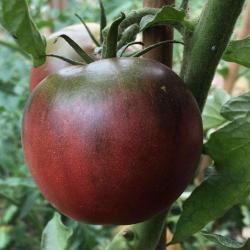Growing tomatoes is a great way to learn new concepts for beginning gardeners, as well as offering new challenges for experienced growers. Assuming you have the right growing conditions, they CAN be fairly easily grown by following a few basic guidelines. The rest is up to trial and error, and what I describe as an 'understanding' that can only be developed through experience. The tips offered below provide a solid starting point from which to build upon through trial and observation.
Start with the right varieties for your growing conditions. Some varieties are better suited to certain locations based on weather, pests, length of day, sun exposure, etc. In addition, decide if you want to plant determinate or indeterminate varieties. This will help in planning the space and growing requirements.
I grow mostly indeterminate varieties because I think they taste better (generally speaking), there are many more options available, and they are often heavier yielding. I also prefer to stagger the harvest.
With determinate varieties, fruit generally ripens at about the same time which is great for processing. In addition, determinate varieties usually have a more controlled growth habit and typically don't require as much vertical support. These traits are often ideal for smaller spaces and containers, but can limit overall yield. Shop for tomato seeds.
Provide well drained, compost rich soil. One part peat moss, one part compost, and one part top soil usually does the trick for raised beds. For established beds, just mix about 2 inched of compost into the top 6 inches or so. If growing in the ground, test your soil, and amend it as required. Though the optimal soil mix will vary based on your local conditions and the types of plants you'll be growing, this mix generally works well for tomatoes. If you live in a region that gets a lot of rain, consider adding pearlite, or vermiculite to aid with drainage.
Trim off lower leaves 12 in. From soil level. As your plants grow to be about 2–3 ft. tall, over a period of a couple of weeks, trim the low lying leaves to help prevent the spread of disease and prevent pests. This is a commonly overlooked practice that can often make or break your season.
Keep weeds under control. It sort of goes without saying, but it's easy to let them get out of hand. Weeds can cause all sorts of problems by harboring pests and diseases, stealing nutrients and water, strangling roots and stems, blocking sunlight, and even releasing growth inhibiting chemicals into the soil in some cases (just to name a few).
Keep a consistent watering schedule. Tomatoes need adequate water, but will suffer if they get too much. It's tricky because the amount they need will vary as they mature and the weather conditions change.
As a general rule, only water if the soil is dry 1–2 in. deep. Too much or inconsistent watering increases the chances of disease, can limit nutrient uptake, and can make fruit crack. Stick your finger in the soil to feel for moisture. It doesn't need to be wet, only moist. When watering is needed, try to avoid getting the leaves wet, also to help prevent disease.
Remove 'suckers' from indeterminate varieties. They can be found growing in between a branch and the stem. This prevents the plant from creating multiple stems. Though you could choose to let them all grow out (and some growers do), they can very quickly become unmanageable, overgrown, and susceptible to disease. In addition, though you will have big bushy green plants, the yield can suffer unless you have a very long growing season. The later fruit sets may not have time to mature before the first frost.
You don't have to remove every last sucker. Truth is, it's hard to get them all. And depending on their habit and available growing space, some plants I let grow into 2 stems intentionally. It just depends on the plant and available real estate. But in general, by keeping this new growth in check, the plant's resources are better directed toward the maturing fruit. Don't remove any new growth from determinate varieties, that's where the fruit will set.
There is quite a bit of debate surrounding 'suckers' and whether or not they should be removed or left to grow 'wild'. Some gardeners simply don't see the need, or feel it causes more harm than good. In my experience it's well worth the time, allowing for more efficient use of space as well as healthier plants. It really just depends on your objectives, methods, available resources, growing conditions, and limitations.
Address diseases and pest issues quickly before they get out of control. Some diseases will not just kill the infected plant, but will easily spread to others if not mitigated quickly. As hard as it may be, it may mean removing one that isn't responding well to treatment to save the others. There are many organic pest and disease control products available. I find neem oil works well for most pests and diseases I've battled.
Have fun and experiment. No doubt you will make many mistakes, from which valuable experiences can be gained. What originally attracted me to horticulture was the freedom to try new techniques and methods. There is no single right way. There are general principles that can be followed to increase your chances at success. That leaves a whole lot of room for each individual grower to experiment and determine the best tricks and methods for themselves.

[ Permalink ]